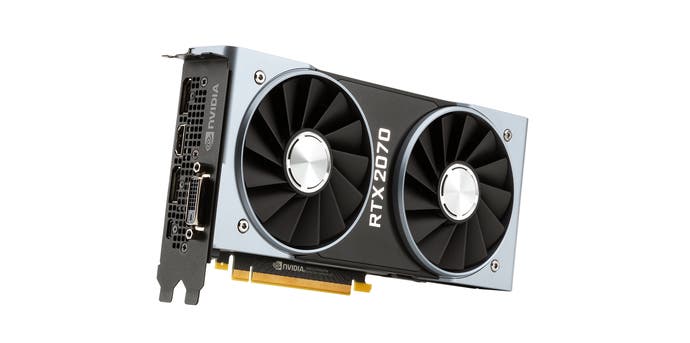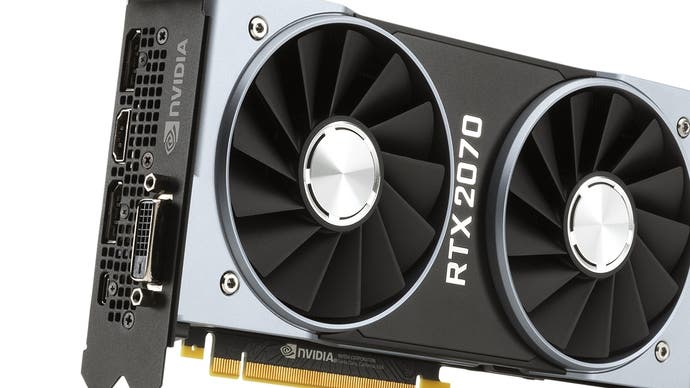Nvidia GeForce RTX 2070 benchmarks: faster than the GTX 1080
But DLSS support will make or break the product.
The GeForce RTX 2080 and 2080 Ti are unapologetically high-end graphics cards with price points to match, but the RTX 2070 is intended to be a more affordable mid-range option that still delivers excellent performance. The idea here is to provide similar levels of graphical grunt to the outgoing GTX 1080 plus the same novel features as the other RTX cards, namely real-time ray tracing (RTX) and deep learning super sampling (DLSS). In this article, we'll show you exactly what kind of performance you can expect out of the card in a wide range of recent game releases, and how the RTX 2070 compares to its closest competitors from Nvidia and AMD.
It's these performance numbers that will form the bulk of this story, but we'll also briefly cover the card's DLSS capabilities. While DLSS has only appeared in a few games, this tech could still become a crucial point of differentiation for the RTX 2070 against its nearest rival, the GTX 1080, as it has the potential to unlock considerable extra performance built into the Turing architecture.
The RTX 2070's performance will be measured against its bigger brother, the RTX 2080, plus two 10-series cards, the GTX 1080 and GTX 1080 Ti. We'll also compare the 2070 against AMD's second-best graphics card, the RX Vega 64, even though it is somewhat cheaper than Nvidia's offerings. Our testing was performed at 1440p and 4K to best show the difference between these cards, as 1080p testing is often too CPU-limited - even with a Core i7 8700K pinned to 4.7GHz. Before we get into the benchmarks, it's worth noting that the Nvidia Founders Edition cards we're testing come with a factory overclock applied, something that wasn't true of Founders Edition GTX 10-series cards. That means that the RTX cards get a small boost over their GTX brethren - not entirely fair, but it is representative of the performance differential between these two cards out of the box.

| RTX 2080 | RTX 2070 | GTX 1080 Ti | GTX 1080 | Vega 64 | |
|---|---|---|---|---|---|
| GPU cores | 2944 | 2304 | 3584 | 2560 | 4096 |
| Giga Rays/sec | 8 | 6 | 1.21 | 1? | ? |
| RTX-OPS | 60T (57T) | 45T (42T) | 12T | 8T | ? |
| VRAM | 8GB GDDR6 | 8GB GDDR6 | 11GB GDDR5X | 8GB GDDR5X | 8GB HBM2 |
| Memory Bus | 256-bit | 256-bit | 352-bit | 256-bit | 2048-bit |
| Mem. Bandwidth | 448GB/s | 448GB/s | 484GB/s | 352GB/s | 439GB/s |
| Base Clock | 1515MHz | 1410MHz | 1480MHz | 1607MHz | 1200MHz |
| Boost Clock | 1800MHz (1710MHz) |
1710MHz (1620MHz) |
1582MHz | 1733MHz | 1536MHz |
| TDP | 225W (215W) | 185W (170W) | 250W | 180W | 295W |
The table above includes the Founders Edition figures, with the reference equivalents in parentheses.
We introduced a new benchmarking system last spring, and we've used it again for our RTX 20-series results here. Rather than using static bar charts or videos with burned-in telemetry, we've built a dynamic system that allows you to watch each test scene play out with live frame-rate and frame time data from just the cards and resolutions you're interested in. Simply hit the play button on the video, then add or remove cards and resolutions using the controls to the right. Below the live feed, you'll also see more conventional bar charts summarising the average frame-rates throughout the scene. Mouse over the chart to see the actual figures, including the oft-illuminating best and worst one per cent figures. You can also click to switch between absolute figures and percentages. Now, let's get into the results!
Assassin's Creed Odyssey
First up is a new addition to our benchmark suite, Assassin's Creed Odyssey. This 2018 release stresses both CPU and GPU, so even our overclocked and liquid-cooled Core i7-8700K can limit performance at 1080p and 1440p. The RTX 2070 just about manages to push past 60fps at 1080p, outperforming the GTX 1080. However, the GTX 1080 Ti still leads the new card by 11 per cent. We see a similar story at 1440p and 4K, with the Vega 64 being the only card to exhibit significant changes between the different resolutions - the AMD card becomes a little more competitive at 4K as its greater driver overhead becomes less of a limiting factor.
AC Odyssey: Ultra High, TAA
Assassin's Creed Unity
In general, we expect a new generation graphics card to rival its immediate predecessor from a higher tier - so the mid-range RTX 2070 ought to provide the same level of performance as the high-end GTX 1080. In a challenging in-game cutscene from late 2014 title Assassin's Creed Unity, the RTX 2070 manages to meet those expectations with ease. At ultra high settings, the new card is five per cent faster than the GTX 1080, turning in a result of 73fps at 1440p and 37fps at 4K. These are excellent results, considering that the mammoth RTX 2080 Ti is the only card we've tested capable of averaging over 60fps at 4K.
Assassin's Creed Unity: Ultra High, FXAA
Battlefield 1
Next up we have Battlefield 1, the 2016 release of the long-running multiplayer-focused shooter series. The brief tank run through no man's land produces some intermittent frame-time jumps, courtesy of randomised nearby explosions, but the trend remains clear: the RTX 2070 outperforms the GTX 1080 by a healthy 11 per cent margin at 1440p. It's a slightly different story at 4K, with the 2070 drawing level with the GTX 1080. Even so, it's still good for an average frame-rate north of 60fps at 4K - not bad for an ostensibly mid-range card! As a general rule of thumb, you can expect frame-rates to drop by about a third if you switch to Battlefield 5, so we would expect healthy frame-rates at 1080p and 1440p but closer to 40fps at 4K in the newer game.
Battlefield 1: Ultra, TAA
Crysis 3
Six years on, Crysis 3 is still a tough challenge for any PC at very high settings with expensive SMAA T2X anti-aliasing. The RTX 2080 Ti was the first graphics card to crack a 60fps average at 4K, with the 2080 only managing 53fps. The 2070 takes another step back, hitting 43fps at 4K. Still, the new GPU manages to out-perform the GTX 1080 at 4K by a few frames per second, keeping its winning streak alive a little longer.
Crysis 3: Very High, SMAA T2X
Far Cry 5
In the 2018 Far Cry release - which comes with one of the most relaxing benchmarks in recent memory - the RTX 2070 leads the GTX 1080 by around six per cent at 1080p. That margin shifts somewhat as we move to 1440p and 4K, but the RTX 2070 is still definitely the better card. The Vega 64 performs better here than in many other titles, thanks to Far Cry 5's support for AMD's rapid-packed math implementation. Ultimately though, the RTX 2070 shows a narrow lead at 4K over the best AMD card released thus far.
Far Cry 5: Ultra, TAA
Ghost Recon Wildlands
Ghost Recon Wildlands is the most challenging game in our current benchmark suite, but the mid-range RTX 2070 card still manages to head off the GTX 1080 by a slim margin. On average, the 2070 turns in 51fps at 1440p and 32fps at 4K, both of which are six per cent ahead of the higher-tier last-gen card. That 4K result doesn't sound great, but it's worth keeping in mind that even the mighty RTX 2080 Ti scores only 47fps in this test!
Ghost Recon Wildlands: Ultra, TAA
Rise of the Tomb Raider
The penultimate Tomb Raider release on PC, 2016's Rise of the Tomb Raider provides a reasonable test of modern graphics cards despite being a poor facsimile of actual in-game performance. The GTX 1080 and RTX 2070 are neck and neck here, with the RTX 2070 scoring 95fps and the GTX 1080 94fps on average at 1440p. It's a similar story at 4K for the 2070 and 1080, at 50fps and 49fps, respectively.
Rise of the Tomb Raider: Very High, SMAA
Shadow of the Tomb Raider
Last year's Lara Croft outing includes an even more challenging benchmark that's also more representative of actual gameplay, making it a much more helpful test to run. Shadow of the Tomb Raider also promises both RTX and DLSS support, both of which could be big draws for RTX 2070 owners in the future. Right now, all we can do is look at traditional performance metrics - and here the RTX 2070 acquits itself well. Averages of 72fps at 1440p and 38fps at 4K mean that the RTX 2070 sits almost exactly between the GTX 1080 and GTX 1080 Ti.
Shadow of the Tomb Raider: Highest, TAA
The Witcher 3
The RTX 2070 reprises its role as the midpoint between the GTX 1080 and GTX 1080 Ti in a slightly older title, 2015's The Witcher 3. In our horse-bound tour of the game's city streets, the RTX 2070 is able to deliver a comfortable 95fps at 1440p and 51fps at 4K - a few settings tweaks away from a perfect 4K/60! Meanwhile, the RTX 2080 is able to hit that target with no settings changes required, while the 2080 Ti has some breathing room at an average of 77fps. Just don't turn on Hairworks, which even on a next-gen Nvidia card still brings an absolute ludicrous performance penalty.
Witcher 3: Ultra, Post-AA, No Hairworks
Wolfenstein 2: The New Colossus
Wolfenstein 2 is another recent addition to our benchmark suite, providing an excellent showcase of the id Tech 6 engine and a tough test for any graphics card. At 4K, the RTX 2070 manages to deliver over 60fps on average, 19 per cent ahead of the GTX 1080. The RTX 2070 is still the baby of the new RTX cards though, with the RTX 2080 achieving a 23 per cent higher result.
Wolfenstein 2 Vulkan: Uber, TSSAA 8X
DLSS vs TAA: Final Fantasy 15
We'll conclude with a look at how this card supports deep learning super sampling (DLSS), as we initially only looked at DLSS performance on the RTX 2080 and 2080 Ti. Thankfully, DLSS works just as well on the 2070 as it does on the higher-end RTX cards, boosting performance in this Final Fantasy 15 demo by almost 40 per cent when switching from TAA to DLSS. In fact, with DLSS enabled, the RTX 2070 comes within striking distance of the RTX 2080 Ti with traditional TAA and 21 per cent ahead of the GTX 1080 Ti. That's a pretty impressive result; once DLSS finally starts appearing on more shipping titles, it could be an absolute game-changer for the RTX series in general and the diminutive RTX 2070 in particular!
Final Fantasy 15 Demo: TAA vs DLSS
With game performance summarised and our short look at DLSS concluded, that's the end of the article. For more details on this exciting new card from Nvidia, check out our full RTX 2070 review or our RTX 2070 video review on YouTube.

